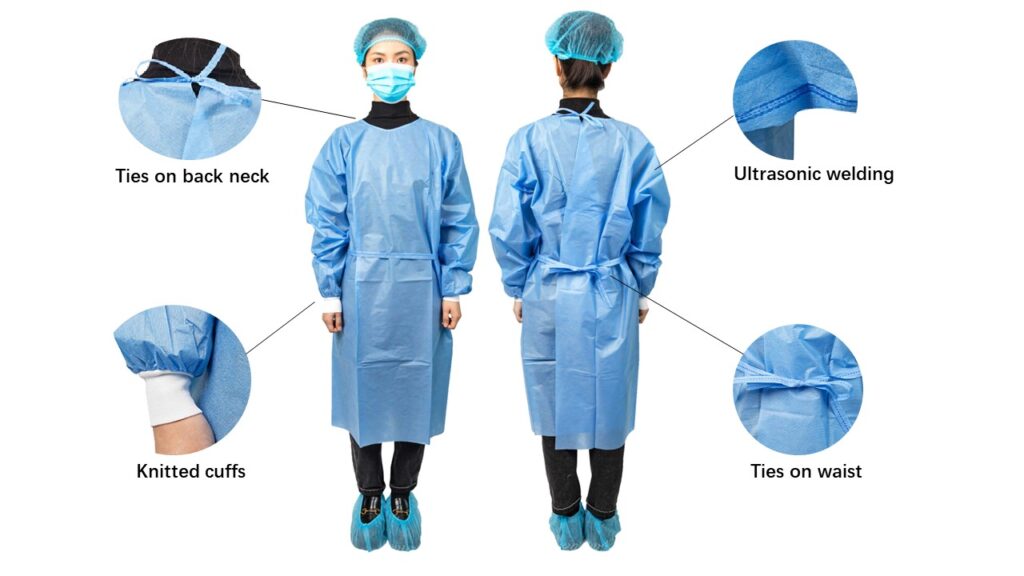Navigating the intricate world of healthcare protective wear can be challenging, given the plethora of options. Let’s delve into a comparison of blue isolation gowns, disposable coveralls, and lab coats to discern their merits and best-use scenarios.

Unveiling the Blue Isolation Gowns
Ubiquitous in a clinical setting, the blue isolation gown is more than just a piece of cloth.
Key Features of Blue Isolation Gowns
Designed for a mix of comfort and protection, these gowns are light, fluid-resistant, and act as a barrier against pathogens. The distinctive blue is not merely for aesthetics but facilitates easy spotting of contaminants.

Use Cases in Healthcare Settings
From outpatient clinics to surgical rooms, these gowns are versatile, offering a balance between protection and flexibility.

Introducing Disposable Coveralls
Think of an all-in-one protective suit, and you’ve got the disposable coverall.
Unique Aspects of Disposable Coveralls
Complete with a hood and booties, coveralls provide full-body coverage. Crafted typically from microporous material, they are both breathable and formidable against spills and splashes.

When to Opt for Coveralls?
Ideal for high-risk environments where comprehensive protection is a priority – think quarantine zones or areas with biohazards.
Spotlight on Disposable Lab Coats
Not just for scientists! Lab coats, although associated with research, play a pivotal role in healthcare.
Characteristics of Lab Coats
Often made from polypropylene or a poly-cotton blend, lab coats are designed for longer wear, with pockets for tools or essentials.
Lab Coats: Beyond the Lab Setting
While quintessential in research settings, they’re also popular in lower-risk healthcare areas, providing both an air of professionalism and a layer of protection.

Comparing on Material and Durability
Isolation gowns often use polyethylene, making them resistant yet disposable. Coveralls, with their microporous fabric, offer durability, especially in challenging environments. Lab coats, meanwhile, lean towards longevity and repeated wear.
Analyzing Coverage and Protection Levels
While isolation gowns cover the torso, coveralls provide an all-encompassing shield. Lab coats, on the other hand, focus on coverage without the constraints, suitable for less hazardous zones.

Weighing the Comfort and Flexibility
Gowns offer the most mobility, perfect for the hustle and bustle of hospital corridors. Coveralls, comprehensive in protection, might feel a tad restrictive. Lab coats strike a balance, giving wearers a mix of protection and comfort.

فعالية التكلفة والأثر البيئي
Gowns, being simpler in design, are often more cost-effective but are meant for single use. Coveralls, given their extensive protection, might be pricier. Lab coats, reusable and sturdy, present an eco-friendlier choice in the long run.
Making the Right Choice for Your Needs
No one-size-fits-all! Depending on the environment, risks involved, and duration of wear, the right protective wear can vary. Assess, compare, and then decide.

الأسئلة الشائعة
- How often should blue isolation gowns be replaced?
- Post each patient interaction or procedure, to ensure maximum protection.
- Can disposable coveralls be reused?
- Typically, no. They’re designed for single-use, especially if exposed to contaminants.
- Are lab coats suitable for surgical settings?
- Not ideal. Surgical settings require stricter protective measures.
- Which offers the most breathable material?
- While all are designed for comfort, coveralls with microporous materials edge out in breathability.
- Why is blue the chosen color for isolation gowns?
- Beyond being visually calming, blue helps in easily spotting contaminants.











